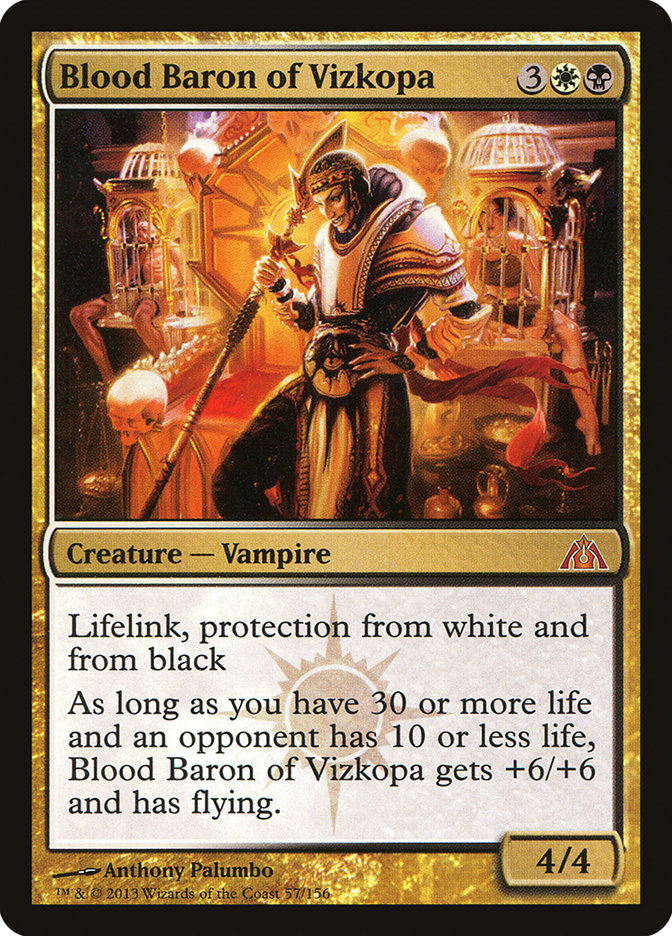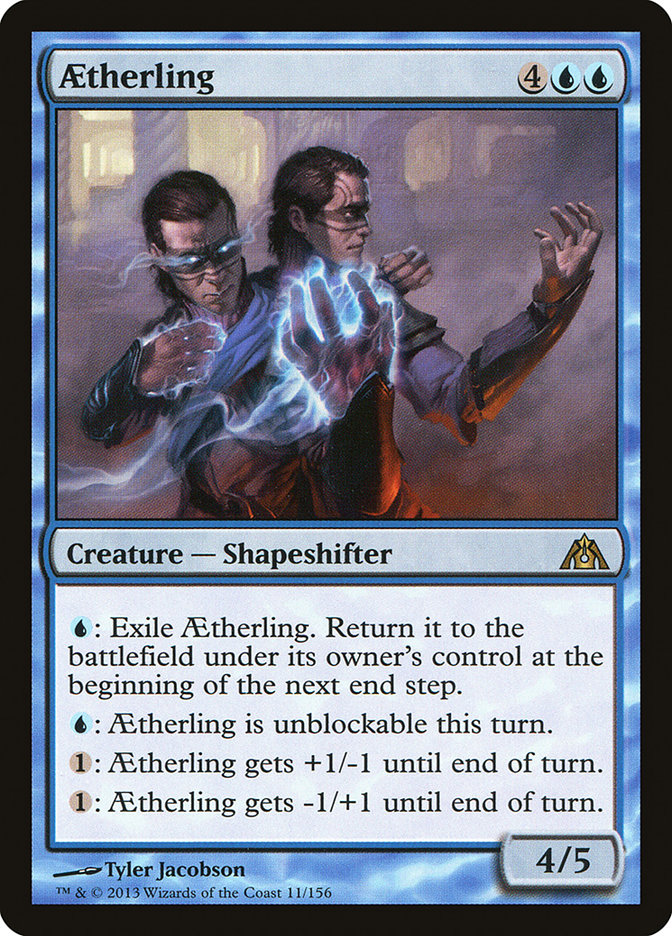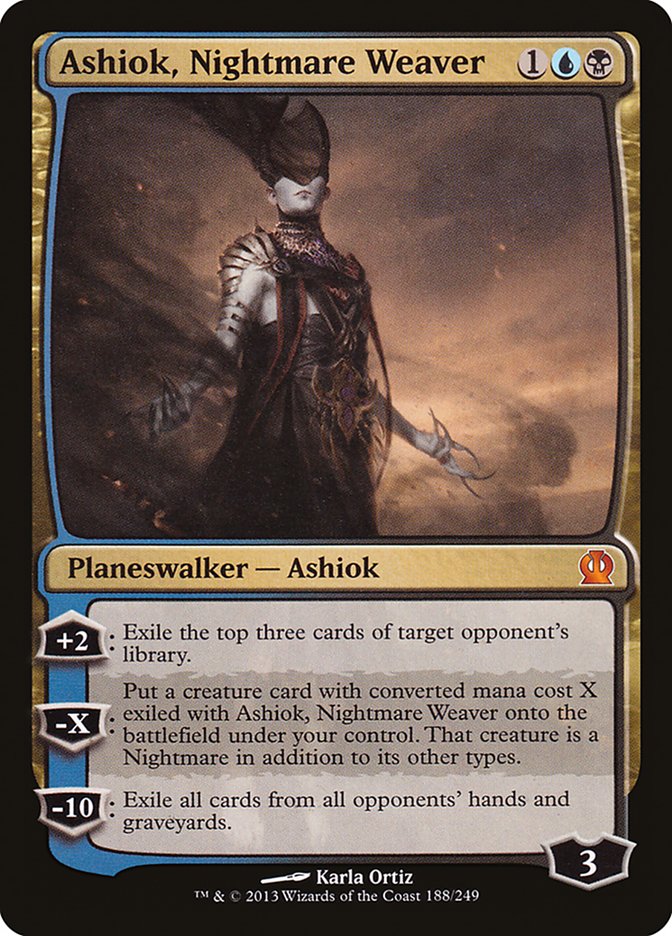We’ve now seen two major Standard tournaments featuring Theros. Pro Tour Dublin and Grand Prix Louisville both indicated that the new set’s flagship mechanic, devotion, will be a defining feature of the format in the months to come.
While Mono-Blue Devotion was the big winner at the Pro Tour, Mono-Black Devotion dominated last weekend’s Grand Prix in the hands of our own Brian Braun-Duin, Brad Nelson, and Todd Anderson. Whatever next week’s flavor of Devotion might be, one trend is clear. Standard—at least right now—is not a format of fast aggro decks.
Going into Grand Prix Louisville, I expected a lot of Devotion decks of all varieties, B/W, some planeswalker midrange decks, and blue control. What better approach to such a field than to choose a deck designed to beat other slow late-game decks?
Here’s the Esper Control deck that William Jensen, Owen Turtenwald, and I played at Grand Prix Louisville:
The proportion of slow decks that showed up and performed well at the Grand Prix exceeded even my expectations! William Jensen piloted Esper to a Top 8 finish, and joining him were five Devotion decks, a second copy of Esper, and one G/R Monsters deck, which was the closest thing to aggro to be found in the Top 8! Because of the dominant performance of these strategies, the problems that Mono-Red Aggro has against Master of Waves, and the problems that Mono-White Aggro has against Lifebane Zombie, all signs indicate that Standard will remain a pretty slow format for the near future. I believe that Esper Control is the perfect choice for such a format.
Traditionally, blue control is king of Magic’s late game. Counterspells are the simplest and easiest ways to take care of the opponent’s late-game bombs, and they ensure that you cannot lose your hold on a game if your opponent topdecks something game changing or assembles an unexpected combo. What’s more is that card draw means that blue players see a much larger portion of their deck and are able to find whatever answers they need and never flood out from drawing too many lands.
Sphinx’s Revelation in particular is one of the best cards in Standard and will likely remain high in the rankings for as long as it’s legal. Once a game goes past turn 6 or 7, everything else simply pales in comparison. At a certain point Read the Bones; Underworld Connections; and even cards like Garruk, Caller of Beasts just cannot keep up with Revelations, meaning that the longer the game goes, the more it’s likely to favor the blue control player.
But why specifically Esper? In my last article, I mentioned that there are a variety of ways to build a Sphinx’s Revelation deck, including Bant and straight U/W.
What Esper gives up in smooth mana and early plays it makes up for in being well rounded and having the ability to answer just about anything in Standard. Hero’s Downfall complements Detention Sphere as an answer to planeswalkers but more importantly serves as an answer to Obzedat, Ghost Council and Stormbreath Dragon, which cannot be effectively handled by sorcery-speed removal and tend to give nonblack control decks fits.
The other effect that black offers access to is Thoughtseize (and to a lesser extent Duress and Sin Collector). I love having Thoughtseize in my deck for its ability to preemptively strip a card that I might not otherwise be able to answer and to see what my opponent is holding and be able to plan the game accordingly.
In reality it’s Thoughtseize that really gives Esper Control its leg up over Standard’s slow decks and against other blue decks in particular.
Thoughtseize
In a blue control mirror, particularly before sideboarding, there are frequently only a handful of cards that really matter. Most lists will have one Aetherling with a few less-effective win conditions and somewhere between two and six counterspells to fight over them. When your Thoughtseize is able to strip one of these precious cards, it gives you a colossal advantage as the game goes long.
As mentioned above, the ability to see the opponent’s hand can have a huge impact on the game as well. As often as you might take away your opponent’s Aetherling, you might see a clear path to resolve your own and accept a quick and easy win. Alternatively, you might see an opponent with an excellent hand and know to settle in for a long grindy game where you’ll have to get maximum value out of all of your cards.
I’d be failing in my duties if I didn’t bring up the fact that Thoughtseize also comes at a fairly high cost. Particularly in Esper Control, which plays twenty lands that come into play tapped and generally just comes out slower than other Standard decks, Thoughtseize can be a real liability. Against a deck like Mono-Red or Mono-White Aggro, where you need to be affecting the board every turn and where two points of life can mean the difference between a win and a loss, you cannot afford to draw a lot of Thoughtseizes.
I would likely not have registered Thoughtseize if I had played Esper in the Pro Tour simply for fear of getting trampled by fast aggro. However, those decks are few and far between in today’s Standard, and Esper is therefore more able to devote a slot or two to hand disruption.
The tiebreaker in favor of Thoughtseize is that it’s also quite good against the Devotion decks. These decks are forced to play a large number of low-impact cards simply to ensure they have the necessary devotion to operate (think Judge’s Familiar, Tidebinder Mage, Burning-Tree Emissary, etc.). This means that they typically have a smaller number of cards on which they depend to actually win a game. More importantly, you know that these cards will always be coming down between turns 3 and 5, so you always know the exact right time to cast Thoughtseize in order to spike your opponent’s Master of Waves or Whip of Erebos.
Blood Baron of Vizkopa
Blood Baron of Vizkopa is another card that I’m not sure I would have played in Pro Tour Theros but am absolutely infatuated with now. With the rise of Mono-Black Devotion and other black-based midrange decks, a threat with protection from black is just what the doctor ordered. Plus you’ll never turn down a 4/4 lifelink creature against fast aggro.
I particularly like the way that Blood Baron combines with Thoughtseize to allow Esper to play a more proactive Junk-like game plan when it’s appropriate to do so. Some opponents will settle into the mindset that you, as an Esper player, are only capable of reacting to what they do and will not know what to do when you suddenly put them on a fast unblockable clock. Black players will not have more than a few after-the-fact answers to Blood Baron of Vizkopa (and rightly so, as loading up on Devour Fleshes would make their deck weak against Esper’s primary game plan), so going Thoughtseize into Blood Baron will result in a lot of easy wins.
As long as Mono-Black Devotion is one of Standard’s top decks, I think it’s perfectly reasonable to maindeck Blood Baron of Vizkopa in Esper Control.
Aetherling
Aetherling is the most reliable win condition available in Standard. It is also one of the only ways to close out a control mirror since your opponent will always have many more answers than you have threats. I would not leave home without an Aetherling.
That said, the card is very pricey and does not have the same ability to immediately swing a game that Blood Baron and Elspeth, Sun’s Champion do. I think it’s a card that needs to be present in your deck but not one that you’re necessarily excited to draw in the early turns of a game.
Elspeth, Sun’s Champion
In my mind Elspeth represents the middle ground between the low-risk Aetherling and the high-reward Blood Baron. Given a few turns Elspeth will win a game very reliably, with the caveat that there are a lot of Detention Spheres and Hero’s Downfalls prowling the top tables of Standard tournaments right now.
I was not particularly impressed by Elspeth in the Grand Prix, but I acknowledge that she is an excellent card and in particular is the best win condition against red and green creature decks.
For future tournaments, I might recommend a threat suite like one Aetherling; one Elspeth, Sun’s Champion; two Blood Baron of Vizkopas.
Ashiok, Nightmare Weaver
The topic of Hero’s Downfall and Detention Sphere brings up the controversial Ashiok, Nightmare Weaver. Some Esper Control players swear by Ashiok, playing three or four copies in their maindeck, and others want nothing to do with the card.
Before the GP I did not fall on the "good" or the "bad" side of the Ashiok argument. However, the one thing that was clear to me was that it was not a card to play in large numbers since it’s a legend that doesn’t have an immediate impact on the board and doesn’t necessarily need to be killed right away. Drawing multiples will often mean cards stranded in your hand doing nothing for you.
At most I wanted to draw one Ashiok, but I wanted zero against fast aggro decks, so I ended up relegating it to the sideboard.
Over the course of the tournament, I only brought Ashiok in a few times and was not impressed when I did manage to put it into play. The biggest problem is that it frequently takes about three or four turns before it can do anything relevant, which gives your opponent too large a window to just answer it at their convenience—or worse to ignore Ashiok and go straight for you!
To put it even more simply, Ashiok doesn’t contribute to Esper Control’s game plan. It’s just one more miscellaneous value card that doesn’t play early defense, which is the last thing that Esper needs. Really, all you want to do is survive until your Sphinx’s Revelations can take the game out of your opponent’s reach, and Ashiok has no place in that strategy. In the future I would play zero.
Card Draw
I’ve already extolled the virtues of Sphinx’s Revelation; I feel it’s the biggest reason to play blue control, and I believe that it’s a mistake to play fewer than four even though it’s such an expensive card. I remember clearly a moment in the Grand Prix when I played a scry land, my hand contained two Sphinx’s Revelations (nothing else), I looked at a third Revelation, and I left it on top. After all, what’s the best play you can make after casting back-to-back Revelations? Frequently, just another even bigger Revelation!
As powerful as Revelation is, you need more than just four card-draw spells in order for your deck to function, plus you need some cheaper card draw to help smooth your draws and hit your land drops.
Jace, Architect of Thought is great because of its double utility against weenie decks. Once in a while it can serve as a backdoor win condition as well.
Jace is an example of a planeswalker that’s actually quite good against Detention Sphere and Hero’s Downfall. If you suspect that your opponent has one of those cards, you can simply use the -2 ability right away and guarantee that you net some card advantage from the exchange.
Rounding things out is two copies of Divination. Divination is a relatively unexciting card, and I predict that it will be one of the first things people look to cut from Esper Control if there’s a pet card that they want to add. However, I caution against this; Divination is a big part of Esper running smoothly and getting mana screwed and mana flooded very infrequently. Helping hit your land drops early is big, and simply making sure that your deck has a critical mass of card draw ensures that you never flood out, which is especially important against people trying to Thoughtseize away every last Sphinx’s Revelation.
One might argue that it’s difficult to take a turn off for Divination against a fast deck, but the counterargument is that it at least increases your chances of hitting Supreme Verdict on turn 4 (it increases both your chances of having the card and of having four proper lands to cast it), which is so often the do-or-die moment in these matchups.
Defense
Aside from mana, every other card not yet mentioned is in Esper Control with the express purpose of helping your survive. Supreme Verdict and Detention Sphere are two of the best cards in Standard, and I can’t imagine playing fewer than four copies of either. Beyond that it’s simply about having a good mix.
To complement the Detention Spheres, two copies of Hero’s Downfall gives a comfortable six answers to planeswalkers. Two Downfalls and one Far // Away is about the minimum you can play if you want to have a fighting chance of beating Obzedat, Ghost Council.
However, you can’t just play all three-mana removal because you’re liable to fall too far behind against very fast aggro. Doom Blade was excellent for me at the Grand Prix since it’s one of the best cards against both Mono-Blue Devotion and the various forms of R/G. However, the card finds itself in an unfortunate position as Mono-Black Devotion begins to cement itself as a top deck in Standard.
You can never go wrong with old faithful Azorius Charm. It represents defense against nearly anything, including haste creatures and flash creatures, and can also be cycled in a control mirror or when you need to hit more land drops.
In response to the dominant showing of Mono-Black Devotion, I would first replace a Doom Blade with the fourth copy of Azorius Charm. Beyond that it’s reasonable to hold fast with one maindeck Doom Blade or to relegate it only to the sideboard.
I opted for a very simple permission suite of three Dissolves. I dislike Syncopate as a card and absolutely hate it in a deck with so many lands that come into play tapped. Most creatures are more effectively answered after the fact by removal spells, so I feel no need for Essence Scatter. Negate is a great card, but I’m fine leaving it in the sideboard.
In many of the fast matchups, I don’t especially want any counterspells. However, I’ve always been a fan of playing a small number of hard counters in the maindeck of any control deck just to be prepared for everything and to make sure you can lock up a game once you pull a little ahead.
Grand Prix Louisville was a successful tournament for Esper Control, and I believe that the deck will only get stronger as time marches on. It’s my first choice for the StarCityGames.com Invitational in Indianapolis this weekend, and I’ll be continuing to work on the deck no matter what happens in that event.
I hope I’ve managed to pique your interest in Esper Control, and I hope you’ll tune into some Standard coverage to see if any one strategy can establish itself as the best in this new format. At least until Mono-Red and Mono-White Aggro make a comeback, I’m betting on Esper.





